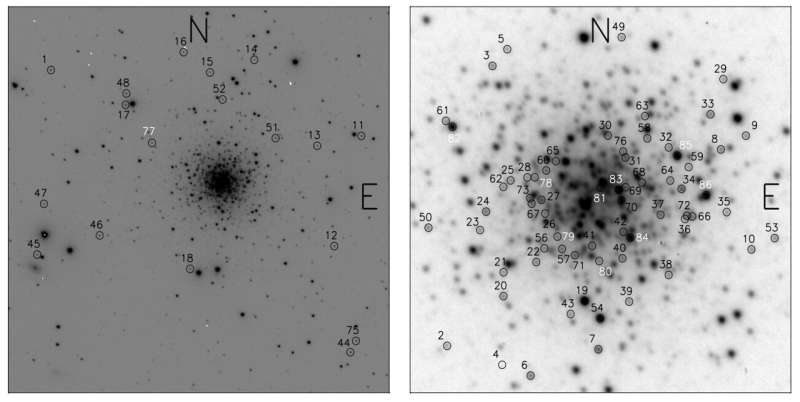December 19, 2022 report
Study inspects population of variable stars in the cluster NGC 7006

Using the Indian Astronomical Observatory (IAO) in Hanle, India, astronomers have observed a globular cluster known as NGC 7006. Results of the study, presented December 9 on the arXiv pre-print server, yield important insights into the properties of variable star population of this cluster.
Globular clusters (GCs) are collections of tightly bound stars orbiting galaxies. Astronomers perceive them as natural laboratories enabling studies on the evolution of stars and galaxies. In particular, globular clusters could help researchers to better understand the formation history and evolution of early-type galaxies as the origin of GCs seems to be closely linked to periods of intense star formation.
Located some 137,000 light years away in the constellation Delphinus, NGC 7006 (also known as Caldwell 42) is a Galactic GC with an estimated mass of about 300,000 solar masses. Previous observations of NGC 7006 have found that it contains at least 76 variable stars of which 64 turned out to be RR Lyrae variables.
In order to shed more light on the population of variable stars in NGC 7006, a team of astronomers, led by Armando Arellano Ferro of the National Autonomous University of Mexico, performed photometric observations of the variable stars in the field of the cluster.
"The observations were performed with the 2 m telescope at the Indian Astronomical Observatory (IAO) in Hanle, India. The detector used was a SITe ST-002 2Kx4K CCD pixels with a scale of 0.296 arcsec/pix, translating to a field of view (FoV) of approximately 10.1 × 10.1 arcmin2," the researchers wrote in the paper.
The team managed to identify 470 stars that are likely members of NGC 7006. Next, they performed a routine search for new variables in this sample. In result, 10 new variables were detected and received variable numbers as follows: two RR Lyrae stars of the RRc type (V77 and V78), two RR Lyrae stars of the RRab type (V79 and V80), one BL Hercules star (V81) and five semiregular (SR) variables (V82, V83, V84, V85 and V86).
The average period of the RRab stars in NGC 7006 was calculated to be 0.577 days and the fraction of RRc stars in this cluster was found to be approximately 0.14. According to the astronomers, these values indicate that NGC 7006 is of Oosterhoff type OoI.
The study found that the weighted mean radius and mass of all the known RRab variables in NGC 7006 are 5.61 solar radii and 0.67 solar masses. When it comes to the RRc stars, these values were measured to be 4.27 solar radii and 0.55 solar masses. The researchers suppose that the main sequence predecessor of RR Lyrae stars in NGC 7006 had a mass of about 0.82–0.85 solar masses and lost between 25% and 35% of its mass during the red giant branch events.
The collected data also allowed the scientists to obtain some fundamental parameters of NGC 7006. They found that the cluster is located approximately 134,200 light years away from the Earth, has a metallicity of -1.53 and its reddening is at a level of 0.08.
More information: A. Arellano Ferro et al, Detailed analysis of the variable star population in the globular cluster NGC 7006, arXiv (2022). DOI: 10.48550/arxiv.2212.05021
Journal information: arXiv
© 2022 Science X Network





















